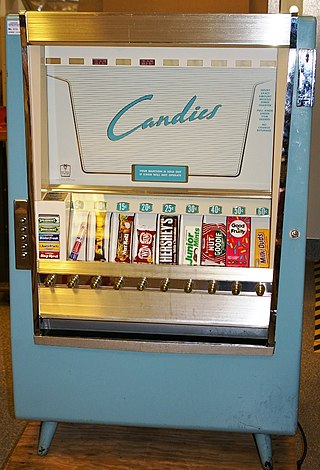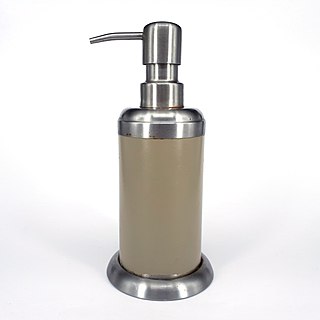
An automated teller machine (ATM) is an electronic telecommunications device that enables customers of financial institutions to perform financial transactions, such as cash withdrawals, deposits, funds transfers, balance inquiries or account information inquiries, at any time and without the need for direct interaction with bank staff.

A pipette is a laboratory tool commonly used in chemistry, biology and medicine to transport a measured volume of liquid, often as a media dispenser. Pipettes come in several designs for various purposes with differing levels of accuracy and precision, from single piece glass pipettes to more complex adjustable or electronic pipettes. Many pipette types work by creating a partial vacuum above the liquid-holding chamber and selectively releasing this vacuum to draw up and dispense liquid. Measurement accuracy varies greatly depending on the instrument.

The point of sale (POS) or point of purchase (POP) is the time and place at which a retail transaction is completed. At the point of sale, the merchant calculates the amount owed by the customer, indicates that amount, may prepare an invoice for the customer, and indicates the options for the customer to make payment. It is also the point at which a customer makes a payment to the merchant in exchange for goods or after provision of a service. After receiving payment, the merchant may issue a receipt for the transaction, which is usually printed but can also be dispensed with or sent electronically.

A vending machine is an automated machine that provides items such as snacks, beverages, cigarettes, and lottery tickets to consumers after cash, a credit card, or other forms of payment are inserted into the machine or otherwise made. The first modern vending machines were developed in England in the early 1880s and dispensed postcards. Vending machines exist in many countries and, in more recent times, specialized vending machines that provide less common products compared to traditional vending machine items have been created.

A transmission is a mechanical device which uses gears to change the speed or direction of rotation in a machine. Many transmissions have multiple gear ratios, but there are also transmissions that use a single fixed gear ratio.
A water dispenser, known as water cooler, is a machine that dispenses and often also cools or heats up water with a refrigeration unit. It is commonly located near the restroom due to closer access to plumbing. A drain line is also provided from the water cooler into the sewer system.
The term dispenser typically imply a machine or container which is designed to release a specific amount of its content, usually liquids or powders/fine granular materials.

A car wash, carwash, or auto wash is a facility used to clean the exterior, and in some cases the interior, of cars. Car washes can be self-service, full-service, or fully automated. Car washes may also be events where people pay to have their cars washed by volunteers, often using less specialized equipment, as a fundraiser.

Coffee service refers to the many and various styles in which coffee is made available to people, such as in restaurants and hotels. In particular, it sometimes refers to the set of dishes and vessels utilized to serve and consume coffee, akin to the notion of a tea service.

A tape dispenser is an object that holds a roll of tape and has a mechanism at one end to shear the tape. Dispensers vary widely based on the tape they dispense. Abundant and most common, clear tape dispensers are commonly made of plastic, and may be disposable. Other dispensers are stationary and may have sophisticated features to control tape usage and improve ergonomics.

A paper-towel dispenser is a device that dispenses paper towels in a public toilet so that hands can be dried after hand washing. Some are operated by a handle, some by pulling the paper from the dispenser, and others by automatic dispensation in response to a motion sensor.

A soap dispenser is a device that, when manipulated or triggered appropriately, dispenses soap. It can be manually operated using a handle or can be automatic. Soap dispensers are often found in public toilets.
Teller Assist Units (TAU), also known as Automatic Teller Safes (ATS) or Teller Cash Dispensers (TCD), are devices used in retail banking for the disbursement of money at a bank teller wicket or a centralized area. Other areas of application of TAU include the automation of starting and reconciling teller or cashier drawers (tills) in retail, check cashing, payday loan / advance, grocery, and casino operations.
Automated cash handling is the process of dispensing, counting and tracking cash in a bank, retail, check cashing, payday loan / advance, casino or other business environment through specially designed hardware and software for the purposes of loss prevention, theft deterrence and reducing management time for oversight of cash drawer an unable operations.

The toothpaste pump, also known as a toothpaste pump dispenser, is a device used to contain and dispense toothpaste, akin to a tube. An automatic toothpaste dispenser is a self-starting way to dispense toothpaste.

A checkweigher is an automatic or manual machine for checking the weight of packaged commodities. It is normally found at the offgoing end of a production process and is used to ensure that the weight of a pack of the commodity is within specified limits. Any packs that are outside the tolerance are taken out of line automatically.

An instant hot water dispenser or boiling water tap is an appliance that dispenses water at about 94 °C (201 °F) (near-boiling). There are hot-only and hot and cool water models, and the water may be filtered as well as heated. Instant hot water dispensers became popular in the 1970s. Instant hot water dispensers are very similar to portable shower devices; the latter is fitted with a heating element and quickly heats up water, once a switch has been activated.

An automatic soap dispenser is a device that dispenses a controlled amount of soap solution. They are often used in conjunction with automatic faucets in public restrooms. They function to conserve the amount of soap used and stem infectious disease transmission.

A media dispenser or a culture media dispenser is a device for repeatedly delivering small fixed volumes of liquid such as a laboratory growth medium like molten agar or caustic or volatile solvents like toluene into a series of receptacles. It is often important that such dispensers operate without biological or chemical contamination, and so must be internally sealed from the environment and designed for easy cleaning and sterilization before use. At a minimum, a media dispenser consists of some kind of pump connected to a length of discharge tubing or a spout. Dispensers used in laboratories are also frequently connected to microcontrollers to regulate the speed and volume of the medium as it leaves the pump.

A beer tower is a beer dispensing device, sometimes found in bars, pubs and restaurants. The idea behind beer towers is that several patrons in a group can serve themselves the amount of beer they want without having to order individually.
















